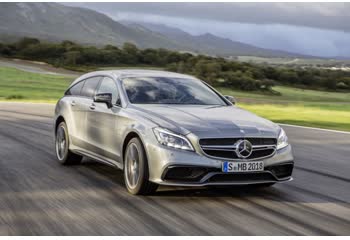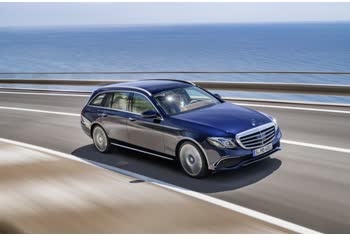Everything you need to know about specifications and performance - Mercedes-Benz CLS 2018 - CLS 450 (367 Hp) EQ Boost 4MATIC 9G-TRONIC

Overview:
What is the engine capacity of a Mercedes-Benz CLS 2018?
The engine capacity of the Mercedes-Benz CLS 2018 is 2999.
Mercedes-Benz CLS 2018 How many horsepower?
The engine power of the Mercedes-Benz CLS 2018 is 367 Hp.
What is the Mercedes-Benz CLS 2018 engine?
Mercedes-Benz CLS 2018 engine is M 256.930. (Click to see other cars using the same engine)
How much gasoline does a Mercedes-Benz CLS 2018 consume?
The Mercedes-Benz CLS 2018 consumes 7.5-7.8 liters of gasoline per 100 km
General:
Brand: Mercedes-Benz
Model: CLS
Generation:Coupe (C257)
Modification (Engine): CLS 450 (367 Hp) EQ Boost 4MATIC 9G-TRONIC
Start of production: 2018
End of production: 2021
Powertrain Architecture:MHEV (Mild Hybrid Electric Vehicle, power-assist hybrid, battery-assisted hybrid vehicles, BAHV)
Body type:Coupe
Seats: 5
Doors: 4
Engine:
Engine systems: Start & Stop System
Power: 367 hp
Power per litre: 122.4 hp/l
Torque: 500 nm
Engine Model/Code: m 256.930
Engine displacement: 2999
Number of cylinders: 6
Engine configuration: Inline
Number of valves per cylinder: 4
Fuel injection system: Direct injection
Engine aspiration: Twin-scroll turbo, Intercooler
Valvetrain: DOHC
Engine oil capacity: 8.5 l
Coolant: 12 l
Engine layout: Front, Longitudinal
Cylinder Bore: 83 mm
Piston Stroke: 92.4 mm
Compression ratio: 10.5:1
Performance:
Fuel Type: Petrol (Gasoline)
Fuel consumption (economy) - urban: 9.8-10.1 l/100 km
Fuel consumption (economy) - extra urban: 6.1-6.4 l/100 km
Fuel consumption at Low speed (WLTP): 8 l/100 km
Fuel consumption at very high speed (WLTP): 9.1 l/100 km
Fuel consumption (economy) - combined: 7.5-7.8 l/100 km
Emission standard: Euro 6
Acceleration 0 - 100 km/h: 4.8 sec
Acceleration 0 - 62 mph: 4.8 sec
Maximum speed: 250 km/h, Electronically limited
Weight-to-power ratio: 5.1 kg/Hp, 196.8 Hp/tonne
Weight-to-torque ratio: 3.7 kg/Nm, 268.1 Nm/tonne
Acceleration 0 - 60 mph: 4.6 sec
Electric system:
Gross battery capacity: 0.9 kWh
Battery technology: Lithium-ion (Li-Ion)
Electric motor power: 22 hp
Electric motor Torque: 250 nm
Electric motor location: Between the combustion Engine and the transmission
Battery voltage: 48 V
Space:
Kerb Weight (kg): 1865
Max. weight (kg): 2585
Max load (kg): 720
Permitted trailer load with brakes (12%): 1900 kg
Fuel tank capacity: 66 l
Permitted trailer load without brakes: 750 kg
dimensions:
Length: 4988 mm
Width: 1890 mm
Height: 1435 mm
wheelbase: 2939 mm
Front track: 1618 mm
Front overhang: 888 mm
Rear overhang: 1161 mm
Ride height (ground clearance): 93 mm
Approach angle: 13.4°
Departure angle: 12.2°
Powertrain, Suspension and Brakes:
Drivetrain Architecture: The Internal combustion Engine (ICE) and the electric motor permanently drive the four wheels of the car with the ability to work only in mixed mode.
Drive wheel: All wheel drive (4x4)
Number of gears and type of gearbox: 9 gears, automatic transmission G-TRONIC
Front brakes: Ventilated discs
Rear brakes: Ventilated discs
Assisting systems: ABS (Anti-lock braking system)
Steering type: Steering rack and pinion
Power steering: Electric Steering
See also

2014 Mercedes-Benz CLS Shooting Brake (X218, facelift 2014) CLS 250 BlueTEC (204 Hp) 4MATIC 7G-TRONIC PLUS
Other generation.
Its production began in 2014 until 2018

Same engine. (M 256.930).
Its production began in 2020 until 2023

Same engine. (M 256.930).
Its production began in 2020 until 2023

Same engine. (M 256.930).
Its production began in 2018 until 2020

Write a comment